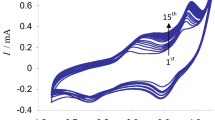Abstract
In routine clinical care rapid results from pH determinations are often desired. This calls for continuousin vivo measurements. Today only intermittentin vitro pH analysis is routinely performed, as the existing transducers do not meet the clinical demands on dimensions, stability, stabilisation time, resolution and ruggedness. Here, some results from a basic experimental study on antimony-antimonyoxide pH electrodes are presented. The purpose of the investigation has been to gain some information on the electrode processes, which govern the electrode response, and to use this information to synthesise more stable and reproducible electrodes than those presently existing. These electrodes are intended, in an appropriate miniaturised form, forin vivo routine pH determinations on homo, e.g in a continuous acid-base balance surveillance application.
Sommaire
Dans les traitements cliniques routiniers, on désire souvent déterminer rapidement le pH. Pour cela, il faut effectuer des mesures continuesin vivo. Aujourd'hui, seule une analyse de pH intermittentein vitro est effectuée de manière routinière, étant donné que les transducteurs existants ne peuvent résolution et la robustesse. Cet article présente certains résultats d'une étude expérimentale fondamentale sur des électrodes de pH du type Sb/monoxyde de Sb. Le but de l'étude était d'obtenir certains renseignements sur les processus auxquels sont soumises les électrodes et qui gouvernent leur réponse, pour pouvoir utiliser ces renseignements en vue de la synthèse d'électrodes plus stables et donnant des résultats plus reproductibles que celles disponibles actuellement. Ces électrodes sont destinées sous une forme suffisamment miniaturisée à déterminer le pHin vivo sur l'homme de manière routinière, c'est-à-dire dans des applications de surveillance continue de l'équilibre acides/ bases.
Zusammenfassung
Bei der klinischen Routinebehandlung sind pH-Bestimmungen oft wünschenswert. Hierzu werden andauerndein vivo Messungen benötigt. Heutzutage werden nur unterbrochenein vitro Analysen als Routineuntersuchungen durchgeführt, da die vorrätigen Meßwandler nicht den klinischen Anforderungen mit Hinsicht auf Größe, Stabilität, Stabilisationszeit, Resolution und Robustheit nachkommen. Hier werden einige Resultate aus einer experimentellen, Grundstudie an Antimon-Antimonoxid-pH-Elektroden dargestellt. Der Zweck dieser Untersuchung war, einige Informationen über Elektrodenverfahren zu sammeln, die den Elektrodenfrequenzgang bestimmen, und diese Information für die Synthese stabilerer und reproduzierbarerer Elektroden als die zur Zeit vorhandenen zu benutzen. Diese Elektroden sind in angemessen verkleinerter Form vorgesehen fürin vivo routinemäßige pH-Bestimmungen im Menschen, wie z.B. bei einer kontinuierlichen Gleichgewichtsbeobachtung auf Säurebasis.
Similar content being viewed by others
References
Cater, D. B. andSilver, I. A. (1961) Microelectrodes and electrodes used in biology. InReference electrodes (Eds. Ives, D. J. G. and Janz, G. J.), Academic Press, 464.
Edwall, G. (1976) Stable and reproducible antimony-antimonyoxide electrodes. TRITA-DISS, 1064. Thesis. Royal Inst. Techn., Stockholm.
Edwall, G. (1977a) Influence of crystallographic properties on antimony electrode potential—I. Polycrystalline material.Electrochim. Acta. (submitted for publication)
Edwall, G. (1977b) Influence of crystallographic properties on antimony electrode potential—II. Monocrystalline material.ibid Electrochim. Acta. (submitted for publication)
Edwall, G. (1977c) Influence of crystallographic properties on antimony electrode potential—III. Oriented monocrystalline material.ibid. Electrochim. Acta. (submitted for publication).
Friedman, S. M. (1967) H+ and cation analysis of biological fluids in the intact animal. InGlass electrodes for hydrogen and other cations (Ed. Eisenman, G.), Arnold, 442.
Geddes, L. A. andBaker, L. E. (1968)Biomedical instrumentation, Wiley, 125.
Green, R. andGiebisch, G. (1974) Some problems with the antimony microelectrode. InIon selective microelectrodes (Eds. Berman, H. J. and Hebert, N. C.), Plenum Press, 43.
Ives, D. J. G. (1961) Oxide, oxygen, and sulfide electrodes. InReference Electrodes (Eds. Ives, D. J. G. and Janz, G. J.), Academic Press, 322.
Karlmark, B. (1973) Determination of titratable acid and ammonium ions in picomole amounts.Analyt. Biochem. 52, 69.
Karlmark, B. andSohtell, M. (1973) The determination of bicarbonate in nanoliter samples.,53, 1.
Kauko, Y. andKnappsberg, L. (1939) Über die Antimonelectrode.Z. Electrochem 45, 760.
Khuri, R. N. (1967) Glass microelectrodes and their uses in biological systems. InGlass electrodes for hydrogen and other cations (Ed. Eisenman, G.), Arnold, 478.
Leidheiser, H., Jun. andGwathmey, A. T. (1947) The influence of crystal face on the electrochemical properties of a single crystal of copper.Trans. Electrochem. Soc. 91, 95.
Malnic, G. andVieira, F. L. (1972) The antimony microelectrode in kidney micropuncture.Yale J. Biol. & Med. 45, 356.
O'Donnell, T. F. (1975) Measurement of percutaneous muscle surface pH.Lancet 533.
Puschett, J. B. andZurbach, P. E. (1974) Re-evaluation of microelectrode methodology for the in vitro. determination of pH and bicarbonate concentrationKidney Int. 6, 81.
Quehenberger, P. (1977) The influence of carbon dioxide, bicarbonate and other buffers on the potential of antimony microelectrodes.Pflügers Arch. 368, 141.
Sekelj, P. andGoldbloom, R. B. (1967) Clinical applications of cation-sensitive glass electrodes InGlass electrodes for hydrogen and other cations (Ed. Eisenman, G.), Arnold, 520.
Stock, J. T., Purdy, W. C. andGarcia, L. M. (1958) The antimony-antimonyoxide electrode.Chem. Revs. 58, 611.
Uhl, A. andKestranek, W. (1923) Die elektrometrische Titration von Säuren und Basen mit der Antimon-Indikatorelektrode. Sitzungsberichte d. mathem.-naturw. kl., Abt. II b,132, 29.
Vieira, F. L. andMalnic, G. (1968) Hydrogen ion secretion by rat renal cortical tubules as studied by an antimony microelectrode.Am. J. Physiol. 214, 710.
Author information
Authors and Affiliations
Rights and permissions
About this article
Cite this article
Edwall, G. Improved antimony-antimony (III) oxide pH electrodes. Med. Biol. Eng. Comput. 16, 661–669 (1978). https://doi.org/10.1007/BF02442445
Received:
Accepted:
Issue Date:
DOI: https://doi.org/10.1007/BF02442445




